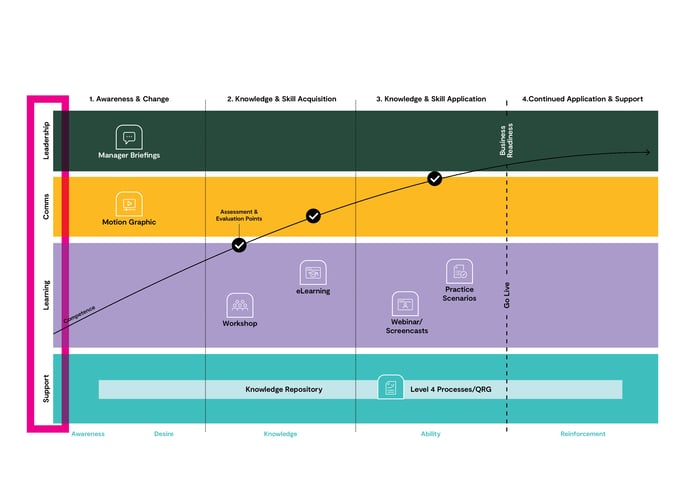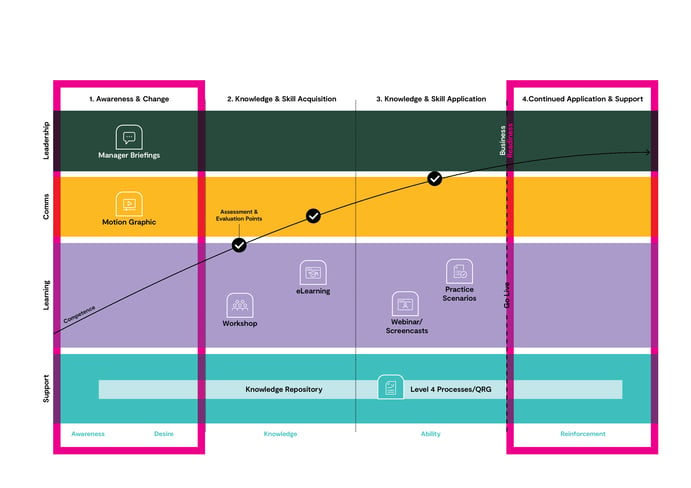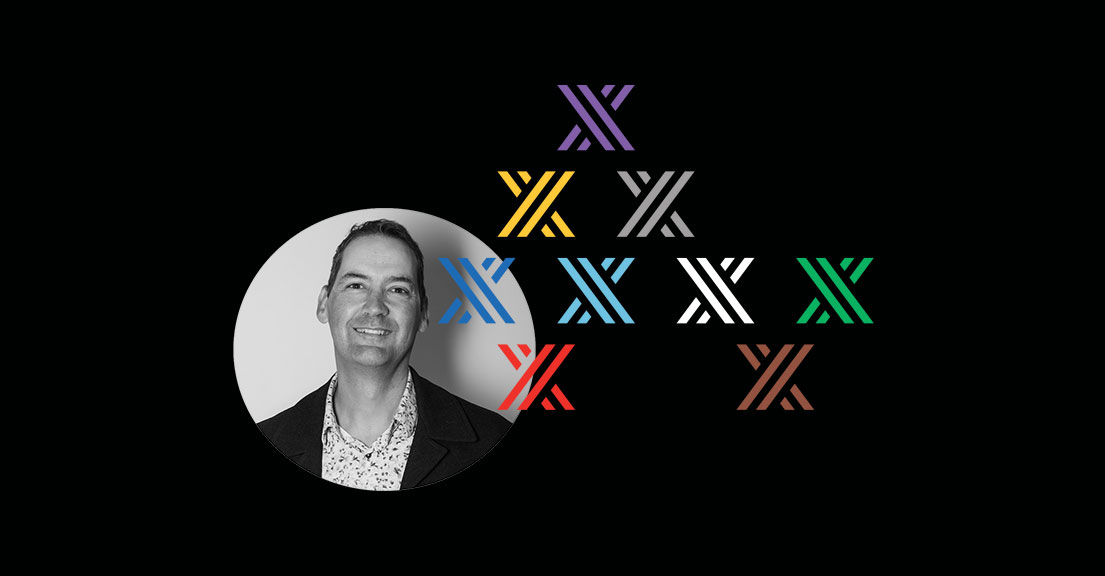Leadership Learning and development Learning campaign Change management Learning Strategy L&D Industry Learning Design
Change Management: 3 Rules for Business Leaders
Think back to when you were little.
Now try to imagine your whānau unexpectedly moving house, without preparing you beforehand that it was going to happen.You might suddenly have your own room, that’s bigger, with a great view, but none of that matters, because everything is different and uncertain.
You wonder if you will be able to sleep alone in your own room. Why can’t things just stay the same?
Former CEO of IBM, Ginny Rometty said “Growth and comfort do not coexist.”
Change, even if it’s for the better, will feel uncomfortable for most people. In the face of change, people might feel uncertain, like everything is different, that they are losing control of their own future and choices, unsure of whether they’re competent in this change or even upset because there was no notice given to prepare them for what was about to happen.
Change management is a very important aspect in the evolution of an organisation and needs to be approached in the right way to get your team excited and ready for it. If you’ve continued reading up till now, chances are that you’re planning to roll out a change within your organisation.
We’ve come up with three rules to consider when planning for change:

RULE #1:
Communicate the ‘why’ (not just the ‘what’)
There’s usually a good and valid reason for change within an organisation, and It’s crucial to communicate this reason to your kaimahi in the correct way.
The why must be the strong focus in the awareness piece to communicate that there’s change happening, when it will happen and most importantly why it will happen. Just like the ‘because I said so’ answer didn’t work on you as a child, it will also not be effective with your team now.
People want to feel like they are a part of the solution and that they were considered in it. If you communicate ‘the why’ effectively, you will have the buy-in of your people and they might even become the early adopters and champions for this change.
Thinking again about the example of suddenly moving house. If attention was given to the why; you will get your own room, with more space and a great view, which will help you to do your homework in peace and quiet, a sense of excitement would’ve been created and you might’ve even helped to pack and load some boxes to accelerate the move.
The most effective way of communicating ‘the why’ is through storytelling.
It's all about taking your people on the journey with you. People need to see what their brighter future with this change will look like. Storytelling can be done through various methods – a 2-minute motion graphic, an interview as a video or podcast, a hui as a department…
This is the place to get creative and determine what method will be most effective to get the word out to your people. Add some food for thought, opportunities to reflect and a bit of inspiration.
The ‘how-to’ incorporate the change will follow, so use this awareness piece purely to create understanding, hope and excitement.

RULE #2:
Stakeholder engagement >
stakeholder management
Change is a detailed and lengthy process which involves many players.
You need to have a team dedicated only to this change project. This team of experts should include leaders, Comms, Learning and Development (L & D) and Support. Even though each of these players will be involved in various stages of the process, it’s important that they’re engaged and have an overview of the entire process.
Knowledge is power. When individuals fully understand where a project is headed they’re able to execute their tasks with the common goal in mind.
In other words, don’t just tell them what you need them to do. Connect it to the larger goal to help drive buy-in and engagement.

Leadership buy-in is crucial as kaimahi will look to their leaders to gauge how they feel about the process and will feed off that energy, or lack thereof. Manager briefings are a great way to introduce the change to their teams and answer any questions and concerns during the awareness phase.
Leaders need to have an overview of the rest of the process and provide support after the go-live date. Regular check-ins on how their team are tracking throughout the process will be beneficial to get an idea of what’s working well and what might be missing. It would also be useful to identify any resistance to the change, and furthermore, could be an opportunity to celebrate successes and quick wins.
Comms will play an important part during the awareness phase in shaping the dialogue and making sure the word gets out. It’s also important that they stay across the rest of the process, to ensure consistency regarding the messaging and brand.
The L&D team will be putting in a lot of the mahi especially during the knowledge and skill acquisition phase. To prepare for this phase they will need to create the deliverables that will best suit the change project. This may include workshops, eLearning resources, webinars/screencasts, podcasts, practice scenarios etc.
For a system change, support may include several roles in IT and administration. They will be involved throughout the process adding the various resources to a knowledge repository, handling issues users may experience and helping with the creation of resources that might continue to support the users after the Go-live date. Perhaps a quick reference guide for the key system steps or FAQs focused on troubleshooting.
H.E. Luccock once said “No one can whistle a symphony. It takes an orchestra to play it.” Teamwork will make the change work.

RULE #3:
Strategy before tactics.
ALWAYS.
It’s quite natural to want to solve problems by diving straight into the ‘doing’ part or solution side of change management. Say for instance it’s a new system being implemented, we want to teach our people how to use the system. We create a few online modules with video tutorials and that should do the trick, right?
Not quite. When you jump straight in there’s a big risk of the change being met with resistance from your kaimahi due to the following reasons:
- There’s no awareness piece preceding the solution to communicate ‘the why’ of the change.
- There’s no continued application and support for the kaimahi to embed the skills and knowledge.

First there needs to be time spent on strategy. A plan and timeline illustrating the different stages of the project. Change is a lengthy process that’s likely to stretch over 6 to 18 months. It shouldn’t be a quick fix, that gets done in a month.
It’s important to continually communicate throughout the change management process. One email or meeting will not result in success. Think about the key messages you need to get across at different points of the change process.
Sean Conner spoke about how the marketing strategy of saying something seven times, can also be applied elsewhere, in his blog ‘Say it 7 Times: The Art of Overcommunication’:
“You must ‘say it seven times’ before a message sticks. Information expands our context. Hearing it for the first time, we become aware of it. As we hear it again, we begin to think critically about it. And through thinking about it, we gain the ability to act on it, to internalise the information as part of our context that we can then use to guide our actions and behaviours. Repetition of the message helps move us through these phases. Saying it seven times doesn’t mean you have to just verbally say it over and over. You can reinforce the message through multiple mediums.”
Even though change is certain to happen in life, it’s never easy. English author, Arnold Bennett once said: “Any change, even a change for the better, is always accompanied by drawbacks and discomforts.”
By following the three key rules mentioned above, you are making the move towards a smoother transition for your people. One with fewer drawbacks and discomforts and greater success.
If you’d like to talk to one of our team about the best approach to an upcoming change initiative, get in touch!
About the author
I'm Frieda, lover dad jokes, fairy-tale endings and outdoor adventures with my family. For almost a decade I designed learning solutions for my Science and Biology high-school students. Now my audience includes a variety of learners from different skill levels and organisations. Since joining Inspire Group, every day has been a meaningful experience collaborating with the team and our clients to design learning that is life changing.
-1.png)




